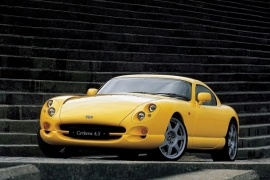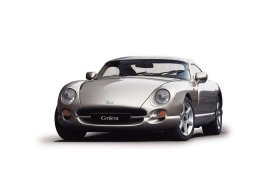TVR Cerbera Models/Series Timeline, Specifications & Photos
First production year: 1996
Engines: Gasoline
Body style: Coupé (two-door)
TVR had to give up on its big round headlights to make the Cerbera looks more appropriate for the 21st century, and it did that by introducing a facelift in 2000 for the 1996 model.
While the British car manufacturer was still independent in 2000, it decided to introduce a facelifted version for the Cerbera lineup, improving the vehicle's look. But while its design department was busy working on the car, the engineering department was concerned about doing something else than improving the engines.
The most striking difference between the 1996 and the 2000 model year was the front. TVR deleted the classic round headlights surrounded by a chromed ring. It replaced them with three scoops on each side: one for the low beam, one for the high beam, and the third one for the turn signals. They took the idea from the Tuscan but re-arranged the lamps. The redesigned bumper sported the fog lamps.
Inside, it was the same unusual interior as in the 1997 model. It still featured the same vent under the steering wheel flanked by a clock and the fuel gauge. A CD stereo found its place on the dashboard, next to the main instrument panel. TVR insisted on installing the wipers, the washer, the horn, and the lights on separate buttons on the steering wheel. The only stalk it provided was for the turn signals, and it was on the right side.
All four engines offered as an option for the Cerbera were ranged between 350 hp and 440 hp, and they sent their power to the rear wheels via a five-speed manual transmission.
While the Cerberus was the three-headed dog that guarded the underworld in Greek mythology, the Cerbera was not his wife, and it was the car that could rip off the distracted drivers' heads.
The British carmaker TVR dared to produce an open-top vehicle for its home market. It wasn't particularly interested in exporting it, so it didn't build it as a left-hand drive. But that was in 1994 when the carmaker's sales were still strong enough to support them.
The Cerbera was a coupe built as a roadster with a hardtop on it. Its long hood and old-school round headlights remained a core characteristic for the car. TVR designers installed the turn signals in the bumper, flanking the broad grille needed to cool the engine. From its sides, the short extended greenhouse didn't look like it belonged to a roadster with a hardtop on it, but the Cerbera had a surprising interior.
Inside, the carmaker installed an interior anything but dull. The instrument panel featured the speedometer and tachometer, while another two gauges were mounted under the steering column, separated by an air-vent! Moreover, TVR dared on installing the wipers, the washer, the horn, and the lights on separate buttons on the steering wheel. The only stalk it had was for the turn signals, and it was on the right side. Behind its sport bucket seats at the front, TVR added a seat and a half in the back, so a child and a toy dog could fill the cabin.
The British carmaker offered four engine choices for the Cerbera ranged between 350 hp and 420 hp. Worth mentioning that the only available gearbox was a five-speed, and there were no electronic nannies to keep the car on the road.

